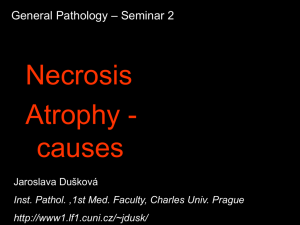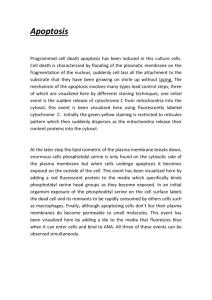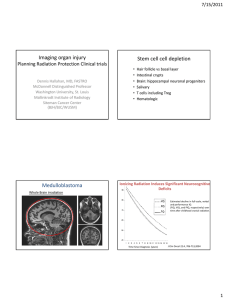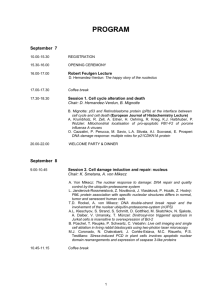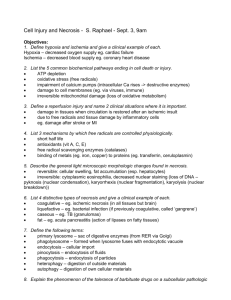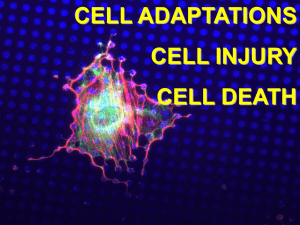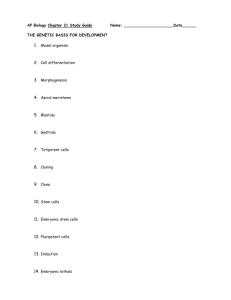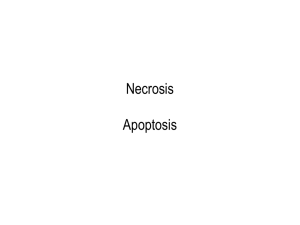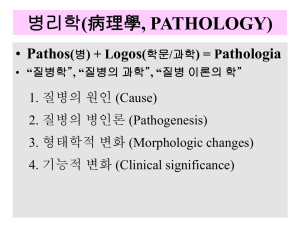File - Wk 1-2
advertisement
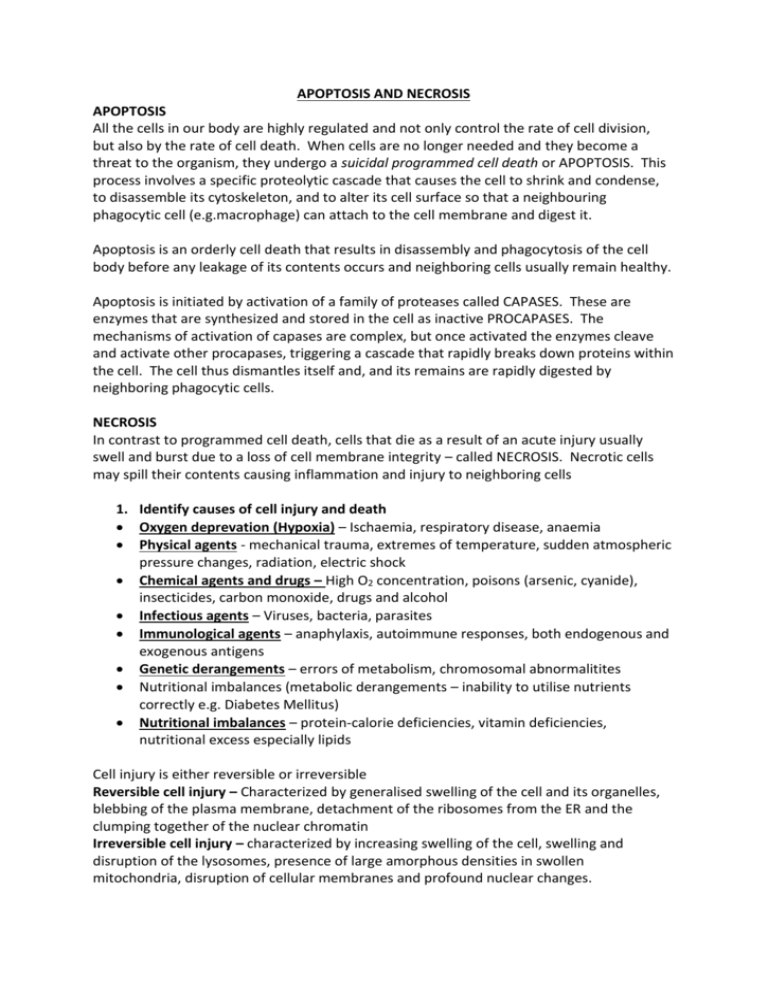
APOPTOSIS AND NECROSIS APOPTOSIS All the cells in our body are highly regulated and not only control the rate of cell division, but also by the rate of cell death. When cells are no longer needed and they become a threat to the organism, they undergo a suicidal programmed cell death or APOPTOSIS. This process involves a specific proteolytic cascade that causes the cell to shrink and condense, to disassemble its cytoskeleton, and to alter its cell surface so that a neighbouring phagocytic cell (e.g.macrophage) can attach to the cell membrane and digest it. Apoptosis is an orderly cell death that results in disassembly and phagocytosis of the cell body before any leakage of its contents occurs and neighboring cells usually remain healthy. Apoptosis is initiated by activation of a family of proteases called CAPASES. These are enzymes that are synthesized and stored in the cell as inactive PROCAPASES. The mechanisms of activation of capases are complex, but once activated the enzymes cleave and activate other procapases, triggering a cascade that rapidly breaks down proteins within the cell. The cell thus dismantles itself and, and its remains are rapidly digested by neighboring phagocytic cells. NECROSIS In contrast to programmed cell death, cells that die as a result of an acute injury usually swell and burst due to a loss of cell membrane integrity – called NECROSIS. Necrotic cells may spill their contents causing inflammation and injury to neighboring cells 1. Identify causes of cell injury and death Oxygen deprevation (Hypoxia) – Ischaemia, respiratory disease, anaemia Physical agents - mechanical trauma, extremes of temperature, sudden atmospheric pressure changes, radiation, electric shock Chemical agents and drugs – High O2 concentration, poisons (arsenic, cyanide), insecticides, carbon monoxide, drugs and alcohol Infectious agents – Viruses, bacteria, parasites Immunological agents – anaphylaxis, autoimmune responses, both endogenous and exogenous antigens Genetic derangements – errors of metabolism, chromosomal abnormalitites Nutritional imbalances (metabolic derangements – inability to utilise nutrients correctly e.g. Diabetes Mellitus) Nutritional imbalances – protein-calorie deficiencies, vitamin deficiencies, nutritional excess especially lipids Cell injury is either reversible or irreversible Reversible cell injury – Characterized by generalised swelling of the cell and its organelles, blebbing of the plasma membrane, detachment of the ribosomes from the ER and the clumping together of the nuclear chromatin Irreversible cell injury – characterized by increasing swelling of the cell, swelling and disruption of the lysosomes, presence of large amorphous densities in swollen mitochondria, disruption of cellular membranes and profound nuclear changes. Mechanisms of cell injury: The cellular response to cell injury depends on the type of injury, its duration and its severity The consequences of cell injury depend on the type, state and adaptability of the injured cell Cell injury results from functional and biochemical abnormalities in one or more of several essential cellular components: Aerobic respiration – involving mitochondrial oxidative phosphorylation and ATP production Cell membrane integrity – on which the ionic and osmotic homeostasis of the cell and its organelles depends Protein synthesis The cytoskeleton The integrity of the genetic apparatus of the cell The depletion of ATP has a series of flow on effects including: ↓ activity of the plasma-membrane Na+ pump – this causes Na+ to accumulate inside the cell and K+ to diffuse out thus, causing the cell to swell and the ER to dilate Altered cellular energy metabolism - ↓ ATP →↑anaerobic glycolysis (to maintain the cells energy source) → ↑ Lactic acid and inorganic phosphate formation → ↓ intracellular pH → ↓ activity of cellular enzymes Ca2+ pump failure – causes and influx of Ca2+ into the cell Structural disruption of the protein synthetic apparatus occurs (with prolonged ATP depletion) – causing detachment of the ribosomes from the RER and dissociation of polymers into monomers → ↓ protein synthesis and irreversible damage to mitochondria and lysosomal membranes Mitochondrial damage Mitochondria can be damaged by: ↑ cytosolic Ca2+ Oxidative stress Breakdown of the phospholipids Lipid breakdown products Influx of intracellular calcium and loss of calcium homeostasis Ca2+ ions are important mediators of cell injury. Cytosolic free calcium is maintained at relatively low levels compared to the extracellular levels. This gradient is maintained by the Ca2+ - Mg2+-ATPase. Damage to the cell causes an increase in the cytosolic calcium concentrations due to an influx of Ca2+ across the plasma membrane as well a release of Ca2+ from the mitochondria and ER. This ↑ in Ca2+ in turn activates a number of enzymes with deleterious effects. These enzymes include: ATPases (which ↑ ATP depletion) Phospholipases (cause membrane damage) Proteases (break down membrane and cytoskeleton proteins) Endonucleases (DNA and chromatin fragmentation) 2. Identify the gross and light microscopic appearances of various forms of necrosis and outcomes (inflammation, regeneration, repair) Necrotic cells show ↑ oesinophilia A more glassy homogenous appearance (due to the loss of glycogen particles) Cytoplasm appears vacuolated and moth-eaten (because the enzymes have digested the cytoplasmic organelles Overt discontinuities in plasma and organelle membranes Dilated mitochondria with large amorphous densities Intracytoplasmic myelin figures Amorphous osmiophilic debris Aggregates of fluffy material (denatured protein) NB: See diagrams on p20/21 Robins and Cotran – Pathological Basis of Disease Coagulative Necrosis (see p22 - Robins and Cotran – Pathological Basis of Disease) Preservation of the general tissue architecture Characteristic of hypoxic death of cells in all tissues except the brain Liquefactive Necrosis (see p22 - Robins and Cotran – Pathological Basis of Disease) Characteristic of cell death due to infarction and cell death in the CNS Accumulation of inflammatory cells Dead cells are completely digested Tissue is transformed into a liquid viscous mass Can be creamy yellow in colour due to pus Gangrenous Necrosis Not really a distinctive pattern of cell death When bacterial infection is superimposed, coagulative necrosis is modified by the liquefactive action of the bacteria and associated inflammation (“wet gangrene”) Caseous Necrosis (see p22 - Robins and Cotran – Pathological Basis of Disease) Distinctive form of coagulative necrosis Characteristic of TB infection Caseous – derived from its cheesy white appearance of the necrosed area Necrotic focus appears as amorphous granular debris with a distinctive inflammatory boarder Unlike regular coagulative necrosis, the tissue architecture is completely obliterated Fat Necrosis (see p23 - Robins and Cotran – Pathological Basis of Disease) Not really a distinctive pattern of cell death Descriptive term for focal areas of fat destruction Activated enzymes liquefy fat cell membranes, released fatty acids combine with calcium to produce grossly chalky white areas (fat saponification) 3. Outline the sequence of morphological changes that occur in cells undergoing apoptosis Cell Shrinkage o Cell is smaller in size, cytoplasm is dense and the organelles are more tightly packed together Chromatin condensation o The most characteristic feature of apoptosis o Chromatin aggregates peripherally (under the nuclear membrane) into dense masses of various shapes and sizes o Nucleus may break up – producing 2 or more fragments Formation of cytoplasmic blebs and apoptotic bodies o Extensive surface blebbing then undergoes fragmentation into membranebound apoptotic bodies composed of cytoplasm and tightly packed organelles – with or without nuclear fragments Phagocytosis of apoptotic cells or cell bodies usually by macrophages o Apoptotic bodies are rapidly degraded within lysosomes o Adjacent healthy cells migrate or proliferate to replace the spaces occupied by apoptotic cells 4. List the circumstances in which cell death by apoptosis might be expected Apoptosis in physiological situations The programmed destruction of cells during embryogenesis Hormone-dependent involution in the adult Cell deletion in proliferating cell populations Death of host cells that have served their useful purpose (e.g. neutrophils following acute inflammatory response) Elimination of potentially harmful self-reactive lymphocytes (autoimmune) Cell death by induced cytotoxic T cells (defense mechanism against viruses and tumors, eliminates virus-infected and neoplastic cells) Apoptosis in pathological conditions Cell death produced by a variety of injurious stimuli Cell injury in certain viral diseases Pathological atrophy in parenchymal organs after duct obstruction Cell death in tumors In some situations where cell death is mainly due to necrosis, the pathway of apoptosis may also contribute 5. Outline the biochemistry and molecular biology of apoptosis with particular reference to DNA cleavage, proteases and expression of oncogenes and tumour suppressor genes Protein Cleavage Protein hydrolysis is a specific feature of apoptosis and involves the activation of several members of the cystine protease family called CAPASES. Capases are present in many cells as inactive pro-enzymes, which when activated, induce apoptosis. These capases cleave cellular proteins (lamins) breaking up the nuclear scaffold and cytoskeleton. Capases also activate DNAses which degrade nuclear DNA. DNA breakdown Characteristic breakdown of DNA into large 50-300 kilobase pieces. The fragments may be visualized by agarose gel electrophoresis as DNA ladders. Endonuclease activity also forms the basis for detecting cell death by cytochemical techniques that recognize double stranded breaks in DNA – although internucleosomal DNA cleavage is not specific to apoptosis Phagocytic Recognition Express phosphatidylserine in some outer layers of plasma membranes, in some types of apoptosis, proteins sectreted by phagocytes may bind to apoptotic cells and opsonoize the cells for phagocytosis and early recognition of dead cells by macrophages results in phagocytosis without the release of proinflammatory cellular components.
